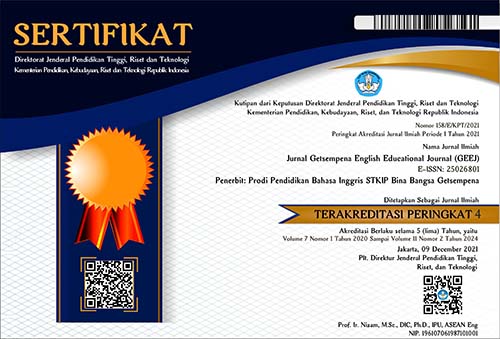THE EFFECTIVENESS OF DICTOGLOSS TECHNIQUE IN TEACHING LISTENING AT SMPN 2 MESJID RAYA
Abstract
In SMPN 2 Mesjid Raya, based on the passing grade of students in listening (75), however only some students got the score reached the passing grade (75). The teacher was confused about this condition because just the big 10 of the classroom who could get the point 70 up. She admitted that the listening comprehension of her students was still low. It was proved by the score that students got on the daily test. That’s why, she added the score of students’ daily test and the task score to improve their points. The writer used experimental research in which there were two classes: one was an experimental group which was taught by using dictogloss, and the other was a control group which was not given any treatment. The students in the control group were taught by using non-dictogloss technique as usually used by the teacher in teaching listening. Based on research findings, it was proven by the value of independent t-test that tobtain<ttable that is 0.59<2.00. Therefore, the null hypothesis is accepted in which both experimental and control groups in the pre-test have a similar ability. In other words, there is no significant difference between the experimental and control classes. However, after the treatments were given, the students who were taught by using dictogloss achieved better listening scores than those taught by means of the conventional technique. It was proved by the result of the dependent t-test of each group by pairing the pre-test and post-test that the result of t-test in the experimental group is higher than that of t-test in the control group (9.063>6.265). It indicates that there is a significant improvement in post-test of the experimental group after dictogloss was introduced. Thus, the null hypothesis is rejected and the alternative hypothesis is accepted. It can be stated that dictogloss is effective in teaching listening that it can increase the students’ listening ability.
References
Anderson, Mark and Kathy Anderson. 2003. Text Types in English 3. South Yarra: Mcmillan.
Brown, Gillian & Yule, George (1983). Discourse Analysis. Cambridge: Cambridge University Pree
Brown, H. G. (2001). Teaching by Principle: Interactive Approach to Language Pedagogy. New York: San Fancisco State University.
Jacobs, G and Small, J. 2003. Combining Dictogloss and Cooperative Learning to Promote Language
Learning. The Reading Matrix. Vol.3, No.1
Krashen, S. (1985). The input hypothesis: Issues and implications. London: Longman Inc
Nunan, D (2003). Practice English Language Teaching. New York: McGraw-hill
Ur, Penny. (1998). A Course in Language Teaching. Practice and Theory. Cambridge Universiti
Press.
Vasiljevic, Z. 2010. Dictogloss as an Interactive Method of Teaching Listening Comprehension to L2
Learners. English Language Teaching. 3 (1), 41-52
Wajnryb, Ruth (1990). Grammar dictation.Oxford: Oxford University Press
Wolvin A, Coakley CW (1996) Listening, 5th edn. McGraw-Hill, Boston.

























